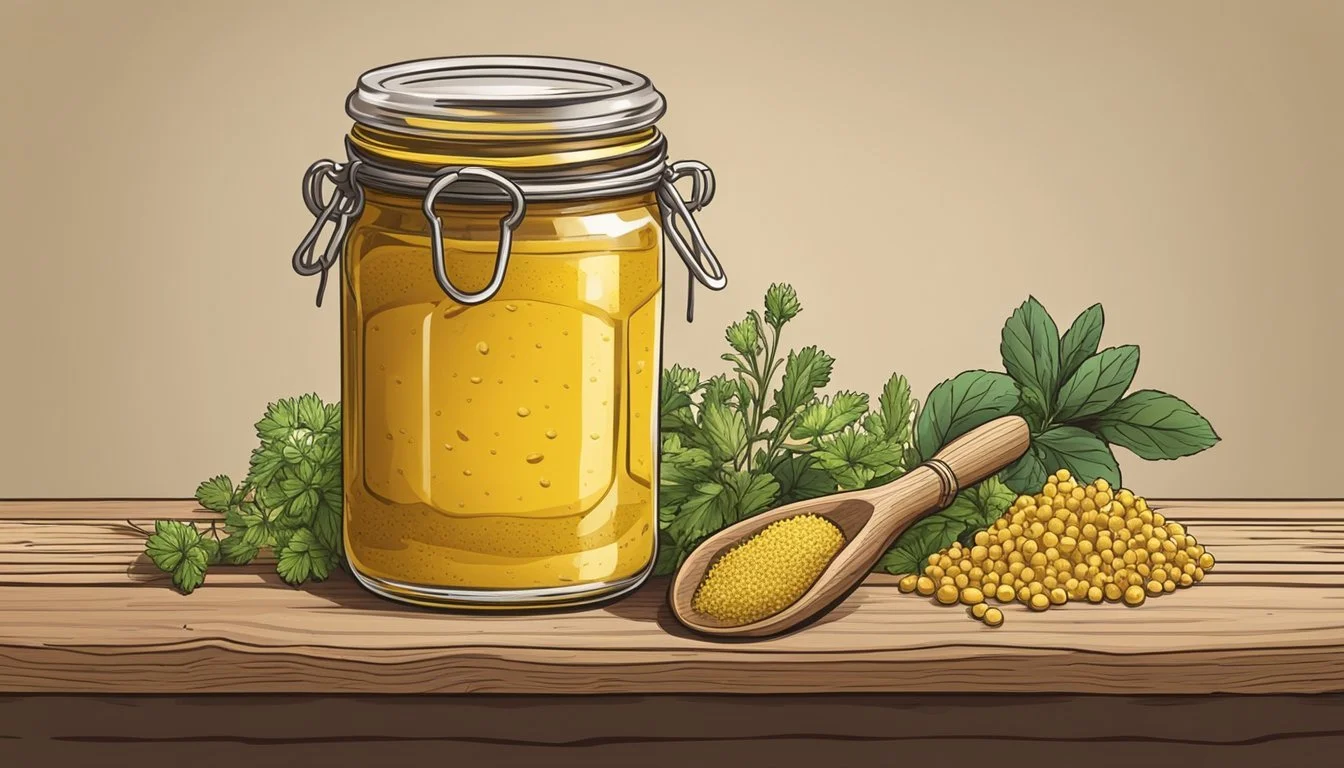How Much French's Mustard Per Day is Excessive?
Understanding Limits for Safe Consumption
When considering the daily consumption of French's mustard, or any mustard for that matter, moderation is key. Mustard is known for its low calorie content and the fact that it adds flavor to dishes without significantly increasing the overall calorie intake. For instance, a teaspoon of prepared yellow mustard contains roughly three calories. Additionally, mustard can offer nutritional benefits; it provides trace amounts of vitamins and minerals such as selenium and manganese.
However, like any condiment, the amount of mustard one should consume daily can vary based on individual dietary needs and health considerations. Despite its health benefits, excessive consumption of mustard may not be advisable. A suggested daily limit for mustard intake is around 1 tablespoon, equivalent to 3 teaspoons. This guideline helps to prevent potential negative health effects that could arise from consuming high amounts of mustard, which may contain added salt and other additives. It is important to understand that while mustard can be part of a healthy diet, it should not be over-consumed.
Understanding Mustard
Mustard is a condiment derived from the seeds of the mustard plant, which various cultures use in different forms. It is known for its sharp, piquant flavor and is used worldwide in culinary applications.
Types of Mustard
Yellow Mustard: Typically made from yellow mustard seeds, this variety is mild and is well known as the classic American mustard, often used on hot dogs and sandwiches.
Dijon Mustard: Originating from Dijon, France, this mustard is creamier, has a sharp, strong flavor, and is made from brown or black mustard seeds mixed with white wine or a mix of other liquids.
Honey Mustard: A sweeter mustard variant, combining the traditional mustard ingredients with honey for a mix of sweetness and bite.
Mustard Composition
Mustard primarily consists of the following:
Mustard Seeds: Can be whole, crushed, or ground into a powder, and are the base for all types of mustard.
Liquids: Water, vinegar, wine, or a combination is used to form a paste with the mustard seeds.
Additional Ingredients: Spices, salt, and sometimes sugar or honey are added for specific flavor profiles.
The exact composition of mustard affects its shelf life, flavor, and dietary impact. In moderate amounts, mustard can add zest to a meal with negligible calories.
Health Implications of Mustard Consumption
When evaluating the health implications of mustard consumption, it is crucial to consider its nutritional content, the associated health benefits, and potential risks. Understanding these aspects can guide daily intake recommendations.
Nutritional Profile
Mustard, particularly the yellow variety that is commonly used as a condiment, is low in calories with approximately 18.8 calories per 2 tablespoons serving. It includes vitamins and minerals such as selenium, manganese, calcium, and thiamin. The striking yellow color of this condiment is attributed to the presence of turmeric.
Nutrient Amount per 2 Tablespoons (1 Ounce) Calories 18.8 Selenium 13% RDA Manganese 6% RDA Calcium 2% RDA Thiamin 6% RDA
Potential Health Benefits
The nutritional components of mustard contribute to its potential health benefits. Mustard contains antioxidants such as isothiocyanates and sinigrin. These compounds have been recognized for their anti-cancer capabilities and may show protective effects against cancers of the breast, lung, gastrointestinal tract, and prostate. The anti-inflammatory nutrients in mustard, including selenium and omega-3 fatty acids, may reduce inflammation linked to several chronic diseases, such as arthritis, type 2 diabetes, and cardiovascular disease.
Risks and Side Effects
While mustard is generally safe for consumption in standard dietary amounts, excessive intake may present health risks. Mustard can be high in sodium, which potentially affects blood pressure and contributes to heart disease. One tablespoon of mustard may be equivalent to consuming 3 teaspoons of salt, thereby increasing the risk of hypertension and cardiovascular disease. Moreover, mustard is a known allergen, and sensitive individuals may experience adverse reactions. It is important for those with conditions like diabetes to monitor condiment intake to manage blood glucose levels effectively. Excessive consumption may also affect cholesterol levels, particularly LDL or "bad" cholesterol.
Daily Consumption Guidelines
When considering the amount of mustard one can safely consume each day, it's essential to refer to dietary experts and nutritional facts. The focus of these guidelines is to balance enjoyment of mustard with its place in a healthy diet.
Recommended Serving Sizes
A standard serving of mustard is typically 1 teaspoon. This portion contains about 3 calories and negligible amounts of fat, carbohydrates, and protein, making it a low-calorie addition to meals. When using mustard as a condiment for foods like sandwiches, it's recommended to adhere to this serving size to maintain its role as a flavor enhancer without significantly altering the nutritional profile of the meal.
Mustard in Different Diets
Mustard can be included in various diets ranging from low-calorie to ketogenic, given its low carbohydrate content. It is particularly versatile in salad dressings where dieters can mix mustard with other ingredients such as apple cider vinegar and olive oil. However, individuals should remain cognizant of the tablespoon measurement often used in homemade dressings, as it equates to three times the standard serving size. Regularly exceeding the recommended teaspoon of mustard could lead to an inadvertent increase in daily caloric intake, although its impact is minor due to mustard's low-calorie nature.
Culinary Uses of Mustard
Mustard adds both flavor and moisture to various recipes and is versatile enough to complement a range of foods from sandwiches to salads and seafood.
Mustard in Recipes
In cooking, mustard is more than just a condiment; it's an ingredient that introduces a tangy depth to dishes. A recipe may call for whole, ground, or powdered mustard seeds, often combined with ingredients like vinegar, water, or even oil to create a paste or sauce. The seeds themselves come from one of three plants: Sinapis alba (white mustard), Brassica juncea (brown mustard), and Brassica nigra (black mustard), each offering varying levels of heat and complexity.
The use of mustard in recipes spans beyond the seeds. Prepared mustards, which combine mustard seeds with a blend of vinegar, water, spices, and sometimes turmeric for color, are widely used to create emulsifications in vinaigrettes or to add zest to marinades. The acidic component of mustard helps in tenderizing meats, making it an effective ingredient in meat marinades.
Pairing Mustard with Foods
Mustard can enhance the flavor of a variety of foods, with French's Classic Yellow Mustard often being a favorite for its mild taste and bright color.
Sandwiches: A smear of mustard can add a zesty twist to sandwiches, complementing meats like ham and turkey while cutting through the richness of cheeses and mayonnaise.
Salads: In dressings, mustard emulsifies the oil and vinegar, creating a stable mixture that coats greens and vegetables evenly.
Fish: Mustard pairs well with fish, offering a piquant contrast to the delicate flavors, whether it's used in a glaze, a crust, or a sauce.
Egg dishes: A touch of mustard in egg salads or deviled eggs brings out a savory fullness that may otherwise be missing.
Mustard's versatility makes it an essential component in the kitchen, capable of elevating a myriad of dishes with its unique flavor and emulsifying properties.
Mustard as a Traditional Remedy
Mustard has long been regarded for its medicinal properties, which include being an anti-inflammatory and antibacterial agent. This section examines mustard's use throughout history until today within the scope of natural medicine.
Historical Medicinal Use
In historical medicinal practices, mustard seeds were commonly used to manage a variety of health conditions due to their perceived healing qualities. They possess antioxidants like isothiocyanates and sinigrin. Traditionally, mustard was thought to have antifungal and analgesic properties, making it a go-to remedy for minor ailments. Some early herbalists valued white mustard seed mixed with honey to clear the voice, an ancient nod to mustard’s anti-inflammatory capabilities.
Contemporary Natural Medicine Applications
In present-day natural medicine, mustard continues to be of interest due to its potential anti-diabetic and wound-healing properties. Research suggests that its antioxidants could offer anti-cancer capabilities, particularly for breast, lung, gastrointestinal tract, and prostate cancers. Recent studies have also looked at the mustard plant for its anti-microbial benefits. However, it's important to note that while mustard is incorporated into many natural medicine applications, discussions on dosages and the threshold for what constitutes 'too much' are still ongoing and require further investigation.
Properties of Mustard Varieties
The properties of mustard varieties are distinguished by their distinct flavor profiles and nutritional content, which vary based on the type of mustard seeds used and additional ingredients.
Flavor Profiles
Dijon Mustard: Originating from Dijon, France, this variety is made from brown mustard seeds and white wine or a mix of vinegar, water, and other liquids. It has a creamy consistency and a sharp, tangy flavor that is more intense than yellow mustard.
Yellow Mustard: Made primarily from white mustard seeds mixed with vinegar and spices, this mustard has a milder, less pungent taste and is bright yellow in color due to added turmeric.
Honey Mustard: This is a blend of mustard and honey, creating a balance between the pungent taste of mustard and the sweetness of honey, resulting in a milder, sweeter flavor compared to other mustards.
Nutritional Differences
The nutritional content of mustard can vary depending on the variety:
Dijon Mustard: Generally contains no added sugar and a small number of calories, making it a suitable condiment for those monitoring their caloric intake.
Yellow Mustard: Low in calories, commonly used as a low-calorie flavor enhancer in a variety of dishes.
Honey Mustard: Higher in calories and sugar content due to the added honey, which should be consumed in moderation, especially by those with dietary sugar restrictions.
Each mustard variety incorporates different proportions of mustard seeds — whole, ground, or bruised — contributing to their unique flavor profiles and nutritional differences. The choice of mustard can be tailored to both dietary preferences and flavor enhancement in culinary practices.
Scientific Research on Mustard
Research has indicated that mustard could have health benefits due to its nutrient content and plant compounds, while agricultural studies examine its cultivation and role in the ecosystem.
Studies on Mustard and Health
Scientists have explored the potential health impacts of mustard, focusing on its nutritional components and bioactive compounds. Mustard contains minerals such as selenium, magnesium, manganese, phosphorus, and calcium, which are essential for various bodily functions. Additionally, it is a source of copper and iron, which are important for maintaining healthy blood cells.
The bioactive compounds found in mustard include glucosinolates and sulfur-containing compounds, which have been studied for their effects on inflammation and potential cancer-fighting properties. Sinigrin, a glucosinolate found in the mustard plant, is of particular interest in scientific research due to its reported abilities to suppress the growth of bacteria and possibly reduce tumor growth.
Carotenoids, another group of compounds present in mustard, are associated with various health benefits, including eye health. Despite the promise shown in test-tube and animal studies, more human research is necessary to confirm these findings and determine the safe and effective daily intake of mustard for health improvement.
Mustard in Agricultural Science
Research in the agricultural sector includes studies on the cultivation of the mustard plant and its impact on soil health. Mustard is recognized for its ability to act as a cover crop, which helps in soil conservation and preventing erosion. Its presence in crop rotations can improve soil structure and fertility due to the high levels of organic matter and fiber it contributes.
Mustard plants also play a role in biofumigation, a process that takes advantage of the natural sulfur-containing compounds in decomposing mustard tissues to suppress soil-borne pests and pathogens. Agricultural scientists continue to study the optimal conditions for growing mustard, its resistance to diseases, and its yield in various climates, considering the influence of global issues such as climate change on mustard production.
Food Industry and Mustard
Mustard is central to the food industry, not only as a popular condiment but also as a key ingredient in various food processes. It offers unique flavor profiles that enhance a myriad of dishes.
Mustard as a Condiment
Mustard is a staple condiment in many kitchens and restaurants. It is typically prepared using mustard seeds, water, vinegar, and various seasonings. White distilled vinegar or white wine can be used in creating different mustard flavors. The most common form of mustard as a condiment is prepared mustard, which is ready to use straight from the bottle. This can be used in simple applications like as a spread on sandwiches or to complement hot dogs. The versatility of mustard allows it to serve as a base for dressing in salads when combined with ingredients like vinegar and fruit pectin, which thickens the dressing for better adherence to greens.
Popular prepared mustards include:
Yellow mustard, often used on hot dogs and burgers.
Dijon mustard, a tangier option frequently used in vinaigrettes.
Whole grain/mustard, where the seeds are visible, providing texture.
Mustard in Food Processing
In food processing, mustard contributes both as a flavoring agent and a natural emulsifier thanks to compounds like xanthan gum. It is commonly found in raw forms in a variety of sauces, where it is valued for both its taste and its ability to blend oil and water-based components seamlessly. Beyond its role in ketchup and specialty sauces, mustard's application extends to marinades and glazes, where it adds depth of flavor and can help to tenderize meats. Industrial food processing utilizes mustard in both its whole seed form and as a ground powder. The emulsifying properties are particularly useful in dressings and sauces, helping to maintain a stable product that can withstand the rigors of mass production and a long shelf life.
Uses in food processing:
Sauces and marinades: Mustard adds tang and spice.
Emulsification: Products like dressings benefit from mustard's binding properties.
Practical Mustard Tips
When using French's mustard or any other mustard brand, proper storage and flavor enhancement are crucial for maintaining quality and taste. These tips can help consumers enjoy their mustard experience to the fullest.
Storing Mustard
Mustard's longevity and freshness are primarily influenced by how it is stored. For optimal preservation, one should refrigerate mustard after opening. French's Mustard, for example, can maintain its quality for 12-18 months in the fridge when tightly sealed. Here are specific storage guidelines:
Refrigeration: Keep opened mustard in the refrigerator to retain its flavor and freshness.
Airtight Containers: Use the original container with a properly fitting lid or transfer to an airtight container.
Consistent Temperature: Store mustard in a part of the fridge with a stable temperature to prevent degradation.
Enhancing Mustard Flavor
To enhance the flavor profile of mustard and make it a more versatile condiment, one can add a variety of ingredients. Here's a breakdown of possible additions and their effects:
Salt and Sugar: A pinch of sea salt can bring out mustard's natural flavors, while a small amount of sugar can balance its tanginess.
Vinegar: White vinegar can add sharpness and zest, enhancing the mustard's overall piquancy.
Spices: Paprika or garlic powder can provide a warm, earthy depth, complementing mustard's sharpness.
Herbs: Incorporating finely chopped fresh herbs or dried herbs can introduce new flavor dimensions to mustard.
By following these storage tips and flavor enhancements, mustard enthusiasts can ensure their condiment remains fresh and delicious every time they use it.
Conclusion on Mustard Consumption
French's mustard, like other condiments, can be enjoyed in moderation as part of a varied diet. Health experts generally advise that condiments should be used sparingly due to high sodium and calorie content that can accumulate with excessive use.
The average mustard consumption in France stands at approximately 2.2 pounds per person yearly—the highest in the world. Although no specific guidelines stipulate an upper limit for mustard intake, one should factor in dietary needs and personal health conditions.
Key Takeaways:
Moderation: Mustard should be consumed in small quantities, treating it as an accompaniment rather than a main dish component.
Sodium Content: Monitor intake especially if one has hypertension or is at risk, as mustard contains sodium.
Calories: While typically low in calories, excessive consumption can add up.
Individuals should consult with a healthcare provider to tailor condiment use, including mustard, to their dietary requirements. Enjoying French's mustard can continue to be a gustatory pleasure without health repercussions when used judiciously.










